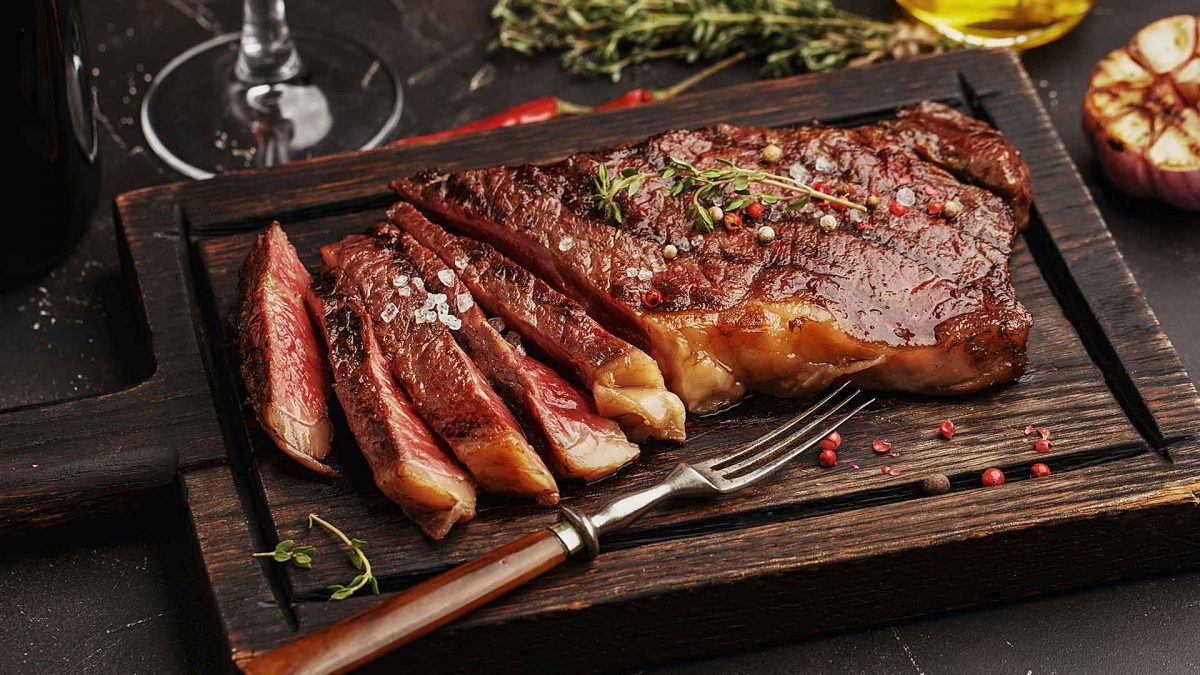There are few things tastier than a good piece of perfectly cooked meat. Tender, silky, and juicy. Enjoying a piece of properly cooked meat is one of the many simple pleasures that life can provide to the palate. This is especially if you prepare it on the grill, where it becomes a culinary star.
Cooking Meat on the Grill
Of all the cooking techniques, perhaps the most complicated of them all is that of the grill. It requires special attention when it comes to preparing it properly, since the slightest detour can spoil it. But achieving perfection is within everyone’s reach, especially if you respect the advice that Guads gives on how to cook a good piece of meat as written below.

Step 1: Always use Prime or Choice meat.
At Guadalajara’s we use only Prime meat, but what does that mean?
For meat to be good, the type of animal and its diet will determine, in general, how soft or hard the meat is and the amount of fat it has.
The USDA (the agency the regulates agriculture, livestock, and food in the Unite States) determines four grades of quality beef: Prime (the best quality), Choice (high quality), Select (lowest quality), and Standard (the worst quality).
These grades of quality refer to the amount of marbling that exists in the meat cut. Marbling is the amount of internal fat that is inside the cut of meat (they are those fine white grains that the meat has), and determines the softness of the meat. The higher the degree of marbling, the higher the quality, and the smoother the cut.
The USDA classifies beef in two ways:
– Quality grades for tenderness, juiciness and flavor
– Degrees of performance for the amount of usable lean meat.
But what do these degrees of quality mean?
* Prime beef: Produced from young, well-fed beef cattle. It has abundant marbling (the amount of fat interspersed with lean meat). Prime roasts and fillets are excellent for dry cooking, such as roasting, roasting, or roasting.
* Choice beef: Has less marbling than Prime. The favorite roasts and steaks of the loin and ribs will be very tender, juicy, and tasty, and are suitable for cooking in dry heat. You can also cook many of the less tender cuts with dry heat so long as you do not overcook them. Such cuts will be more sensitive if you stew, roast, or simmer them with a small amount of liquid in a tightly covered pan.
* Select beef: It is of very uniform quality and is usually more lean than the superior qualities. It is quite sensitive, but because it has less marbling, it may lack the juiciness and taste of higher grades. You should only cook tender cuts with dry heat. For other cuts, you need to marinate them before cooking or stewing for maximum sensitivity and flavor.
* Standard / Commercial beef: Stores frequently sell this as ‘ungraded’ or as branded meat. Retail rarely sells the qualities of meat for general use, cutter, and packaging. Instead, other companies use them to make ground meat and processed products.

Step 2: Cut perpendicular to the muscle fibers.
In Guadalajara’s we cut our own meat so that the meat is as tender as possible. The cut has to be perpendicular to the muscle fibers or grain and should never be done in parallel. In this way, we avoid the muscle fibers being too long and resistant, which makes the meat more tender.
One of the keys is having a well-sharpened knife that will not damage the fibers. Keep in mind that the bigger the grains, the more important the cut when it comes to getting a good flavor and proper hardness of the flesh.
From veal meat, we can make different pieces which are highly appreciated in the kitchen. One of the best cuts is the sirloin, which comes from the short loin of the veal or cow. If we have the whole sirloin, we will start by removing the fat from the outside and then the skin between it and the meat. Be careful not to cut too deep when removing fat, as it is always good to leave a little to maintain juiciness.
If we want is to remove fillets from the back, they are divided into three parts: head, center, and tip. The thickest part is the head. Fillets that you remove from here are chateaubriand. Those on the tip part are the smallest and are filet-mignon. Steaks from the center are turnedós.
From the hip, the round, the counter, or the counter, which are parts with excellent quality, we can also get steaks or steaks. We cut these into thin pieces 3 to 5 millimeters thick and always in the opposite direction of the grains.
Another highly-appreciated piece is the entrecôte. This is obtained from the lower back of the animal. Butchers cut it without removing the complexion or superficial fat. The ribeye and roast beef are removed from the high loin. You will need to debone the latter to roast in the oven. On the other hand, the ossobuco comes from the upper part of the leg by cutting transversely the meat of the hock in thick slices without bone.

Step 3: Cooking the meat:
A piece of meat, well grilled or grilled, has a pink interior color. Some people prefer that the meat is juicy inside and well done on the outside. However, there are others who like the piece to have a uniform color on all sides.
In any case, to ensure a good result, it is important to follow three steps.
It is essential that the surface you use (pan or grill) is very hot. While it is getting to temperature, we prepare the meat. We rub it everywhere with a generous jet of oil, season, and season to taste. Then, place it on the hot pan or grill.
1.- Brown the outside as quickly as possible and evenly on a greased plate and at a very high temperature.
2.- Partially cook the meat at a lower temperature (this step is obvious when the meat is less than one centimeter thick).
The cooking time will depend on the taste of each person, the point to be given to the meat, and the type of cut. As a general rule, a two-centimeter-thick piece needs one minute per side for ‘little done’ for ‘blue’, two minutes for ‘before the dot’ and four minutes for ‘to the point’. During the roast the juices come to the surface and, through them, you can check the status of the meat. When the juices start to come out, then the piece of meat is at a point between ‘little done’ and ‘to the point’. The darker the juices, the more cooked the meat is inside.
In any case, it is essential not to touch the piece of meat while it is roasting, nothing more than to turn it over. Once you roast it in its entirety, you remove it to a dish or source, place it in a warm place, and allow it to stand between a minimum of two and a maximum of five minutes. With this the piece is finished cooking and the juices are evenly distributed.
3.- Let it rest before serving. Once our piece of meat is ready, there is nothing left to do but enjoy it. To make the experience more pleasant, if possible, we must not forget the accompaniments.

Step 4: Cutting to Make Fajitas
If you want to cut the meat to make fajitas, before cutting the meat, as already specified in step 3, it should be left to rest a few minutes so that the juices do not escape.
The resting time varies according to the cut and the size of the piece of meat. A roast, which are large pieces, should stand about 10 minutes, while a steak will be ready between 3 and 5 minutes, depending on the thickness. As a general rule, you should usually apply 1 minute of rest for every 100 grams of meat.
The next step will be to identify in which direction the muscle fibers or grains are distributed. In pieces like filet-mignon they are less visible, and it takes a bit more time to find them.
Final Steps for Preparing the Meat
Next, we will place the blade of the knife at an angle always opposite the direction of the fibers. We will start at one end of the piece to end up at the other.








